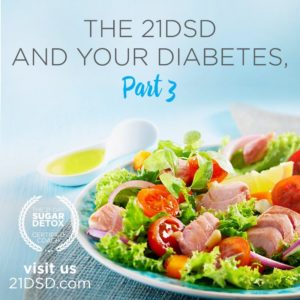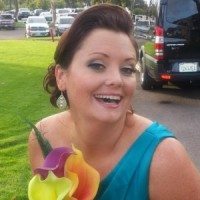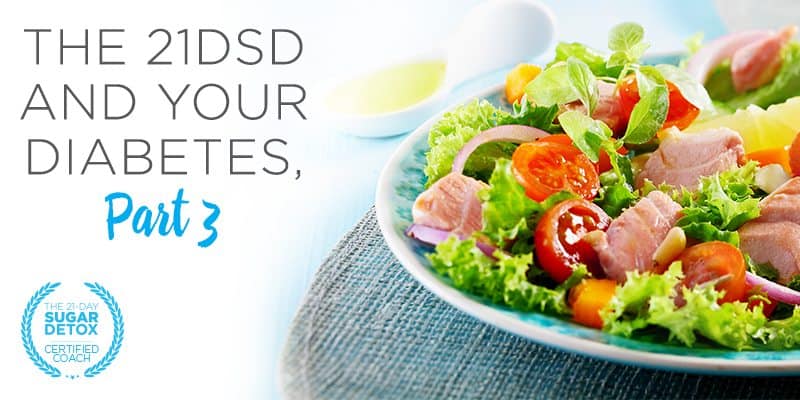Hey Folks! We're excited to welcome back Certified 21DSD Coach Natalie Washabaugh. Natalie's article is part of a series contributed by our Certified 21DSD Coaches. Enjoy! – Diane and Team
**Remember that this information for general information only and is not to be considered professional medical advice, diagnosis, or treatment. Please consult your doctor for personal medical advice.
In Part 1 of this series, I briefly described my journey to health as a type 1 diabetic utilizing the 21-Day Sugar Detox as my guide. I also went over some staggering statistics and definitions that will be useful when reading over the tips below, created to ensure a successful 21DSD. If you missed Part 1, check it out here. In Part 2, I discussed some useful tips that will guide you through your 21DSD with diabetes. Continue reading for more tips on making sure your 21DSD is safe and successful!
Rethink recovery (the down-low on lows)
No one truly understands how low blood sugar feels until they experience it for themselves. The world appears dizzy, small tremors develop in your hands, your skin pales, you start to sweat, your moods become erratic, and if the low blood sugars are not addressed the symptoms can lead to loss of consciousness, seizures, and even coma!
In that moment time seems to pause, and you start shoveling whatever food you can get your hands on into your mouth until the symptoms subside. A diabetic’s recovery approach to low blood sugars can be like purchasing a ticket to the blood sugar roller coaster. Just lean back and anticipate a steep incline. That ticket to ride leads to high blood sugars as too many carbs are consumed in an effort to get your blood sugars back to a level that feels stable.
Most diabetics carry candy, glucose tablets, or juice to treat hypoglycemia. If you look at the Yes/Limit/No Foods List (page 70-Level 1, page 78-Level 2, or page 86-Level 3) you will notice that these foods typically used to treat low blood sugars are a big NO during the 21DSD. In order to remain compliant and avoid hopping on the blood sugar roller coaster it is important to understand the best way to treat your lows.
I follow the 15 grams/15 minutes/2 hours rule when addressing a blood sugar crash:
 First, and possibly the most important, as soon as the symptoms present themselves, TEST! Often times, especially as we age, symptoms for hyper- and hypoglycemia can become convoluted and not as easy to identify. For most people, your blood sugar is considered low when it drops below 60-70 mg/dL.
First, and possibly the most important, as soon as the symptoms present themselves, TEST! Often times, especially as we age, symptoms for hyper- and hypoglycemia can become convoluted and not as easy to identify. For most people, your blood sugar is considered low when it drops below 60-70 mg/dL.- Eat 15 grams of carbohydrates. Choose foods from the Limit Foods List, make a batch of the Tart & Creamy Applesauce (page 194), or drink a serving of kombucha. Kombucha is my go-to for low blood sugar recovery.
- Wait 15 minutes and test again. If your blood sugar levels are increasing, you are on the mend. If there is no change, eat another 15 grams and test again in 15 minutes until levels have increased.
- Once blood sugars seem to be increasing, stop snacking and test again in 2 hours to make sure you have not over-corrected.
Following this 15 grams/15 minutes/2 hours helps to alleviate any over-corrections which can lead to hyperglycemia.
Eat foods for blood sugar balance not spikes
Eating foods for blood sugar balance is not really diabetic specific as it is the basic premise for the 21DSD! Through this program you are teaching yourself to be more mindful of the foods you put into your body and their impacts on your everyday symptoms and overall health. Plan meals that are loaded with vegetables, proteins, and healthy fats to avoid blood sugar spikes and crashes. If you include food items from the Limit List make sure that you know the carbohydrate count and properly medicate.
Meal planning is one of the most important ways to ensure success on the 21DSD, diabetic or not! Planning is even more crucial for diabetics. As a diabetic, you are not only planning each meal but also planning how to combat the possible blood sugar highs and lows. Planning for lows is an especially essential part of your success. Make sure you have foods from the Limit List ready and waiting while you try to manage this new way of eating (see the recovery section above). You can also read my 3-Ps of the 21DSD for ideas on how to prepare yourself for a successful detox.
The 21-Day Sugar Detox Guidebook is full of delicious recipes to keep you satisfied on your journey. There are also recipes available to you on the official 21DSD Facebook page. There you can search for other diabetics who are taking steps to improve their health through the 21DSD. I would also recommend you pick up a copy of the 21DSD Cookbook with even more recipes! Practical Paleo 2nd Edition is a perfect tool to help you transition from your 21DSD to a whole-food way of life and continue to balance your blood sugars.
The 21DSD is an excellent way to get your diabetes back on track. You will learn better blood sugar management and what it really feels like to be a thriving diabetic!
 Natalie Washabaugh M.A. is a Nutritional Therapy Practitioner (NTP) and a 21-Day Sugar Detox Coach focusing on fat loss, blood sugar regulation, body image issues and healing relationships with food, all issues she has personally struggled with as a Type 1 diabetic of 30 years. She loves educating clients on simple mindset shifts, nutrition myths and movement, providing them the tools necessary to nourish themselves mind, body and soul. She is also a certified American Sign Language (ASL) interpreter who strives to bring health and wellness directly to the Deaf community. She enjoys lifting heavy, San Diego sunsets and walking her two puggles, Max and Rambo, on the sandy shores. You can find her blogging sarcastically on her website, Instagram, Twitter and Facebook.
Natalie Washabaugh M.A. is a Nutritional Therapy Practitioner (NTP) and a 21-Day Sugar Detox Coach focusing on fat loss, blood sugar regulation, body image issues and healing relationships with food, all issues she has personally struggled with as a Type 1 diabetic of 30 years. She loves educating clients on simple mindset shifts, nutrition myths and movement, providing them the tools necessary to nourish themselves mind, body and soul. She is also a certified American Sign Language (ASL) interpreter who strives to bring health and wellness directly to the Deaf community. She enjoys lifting heavy, San Diego sunsets and walking her two puggles, Max and Rambo, on the sandy shores. You can find her blogging sarcastically on her website, Instagram, Twitter and Facebook.


Comments 3
Pingback: Practical Tips for Keto + Paleo | What's Up Weekly with Diane | May 31st, 2017
Pingback: The 21DSD and Your Diabetes: Part 2 | The 21-Day Sugar Detox by Diane Sanfilippo
I am a diabetic!!!